2010 NISSAN 370Z COUPE oil change
[x] Cancel search: oil changePage 276 of 409

Black plate (276,1)
Model "Z34-D" EDITED: 2009/ 9/ 10
WARNING
.Do not leave children or adults who
would normally require the support
of others alone in your vehicle. Pets
should not be left alone either. They
could accidentally injure themselves
or others through inadvertent op-
eration of the vehicle. Also, on hot,
sunny days, temperatures in a
closed vehicle could quickly become
high enough to cause severe or
possibly fatal injuries to people or
animals.
. Properly secure all cargo to help
prevent it from sliding or shifting.
Do not place cargo higher than the
seatbacks. In a sudden stop or
collision, unsecured cargo could
cause personal injury (Coupe mod-
els) .
. Closely supervise children when
they are around cars to prevent
them from playing and becoming
locked in the trunk where they could
be seriously injured. Keep the car
locked with the trunk closed when
not in use, and prevent children’s access to car keys (Roadster mod-
els) .
If the engine oil temperature is high, the
engine protection mode, which helps re-
duce the chance of engine damage, could
activate and automatically decrease en-
gine power. Driving while the engine oil
temperature is high may result in engine
damage.
EXHAUST GAS (carbon monoxide)
WARNING
. Do not breathe exhaust gases; they
contain colorless and odorless car-
bon monoxide. Carbon monoxide is
dangerous. It can cause uncon-
sciousness or death.
. If you suspect that exhaust fumes
are entering the vehicle, drive with
all windows fully open, and have the
vehicle inspected immediately.
. Do not run the engine in closed
spaces such as a garage.
. Do not park the vehicle with the
engine running for any extended
length of time. .
Keep the rear hatch/trunk lid closed
while driving, otherwise exhaust
gases could be drawn into the
passenger compartment. If you
must drive with the rear hatch/trunk
lid open, follow these precautions:
1) Open all the windows.
2) Set the
air recirculation to
off and the fan control to high to
circulate the air.
. The exhaust system and body
should be inspected by a qualified
mechanic whenever:
— The vehicle is raised for service.
— You suspect that exhaust fumes
are entering into the passenger
compartment.
— You notice a change in the sound of the exhaust system.
— You have had an accident invol- ving damage to the exhaust
system, underbody, or rear of
the vehicle.
THREE-WAY CATALYSTThe three-way catalyst is an emission control
device installed in the exhaust system. Exhaust
gases in the three-way catalyst are burned at
PRECAUTIONS WHEN STARTING
AND DRIVING5-2
Starting and driving
Page 334 of 409

Black plate (334,1)
Model "Z34-D" EDITED: 2009/ 9/ 10
proper product.
.Wax your vehicle only after a thorough
washing. Follow the instructions supplied
with the wax.
. Do not use a wax containing any abrasives,
cutting compounds or cleaners that may
damage the vehicle finish.
Machine compound or aggressive polishing on a
base coat/clear coat paint finish may dull the
finish or leave swirl marks.REMOVING SPOTSRemove tar and oil spots, industrial dust,
insects, and tree sap as quickly as possible
from the paint surface to avoid lasting damage
or staining. Special cleaning products are
available at a NISSAN dealer or any automotive
accessory stores.UNDERBODYIn areas where road salt is used in winter, the
underbody must be cleaned regularly. This will
prevent dirt and salt from building up and
causing the acceleration of corrosion on the
underbody and suspension. Before the winter
period and again in the spring, the underseal
must be checked and, if necessary, re-treated.
GLASSUse glass cleaner to remove smoke and dust
film from the glass surfaces. It is normal for glass
to become coated with a film after the vehicle is
parked in the hot sun. Glass cleaner and a soft
cloth will easily remove this film.
CAUTION
. When cleaning the inside of the
windows, do not use sharp-edged
tools, abrasive cleaners or chlorine-
based disinfectant cleaners. They
could damage the electrical conduc-
tors, radio antenna elements or rear
window defroster elements.
. If glass cleaner gets on the soft top,
immediately wash it off with clean
water (Roadster models) .WHEELSWash the wheels when washing the vehicle to
maintain their appearance.
.Clean the inner side of the wheels when the
wheel is changed or the underside of the
vehicle is washed.
. Inspect wheel rims regularly for dents or
corrosion. Such damage may cause loss of pressure or poor seal at the tire bead.
. NISSAN recommends that the road wheels
be waxed to protect against road salt in
areas where it is used during winter.
CAUTION
Do not use abrasive cleaners when
washing the wheels.Aluminum alloy wheelsWash regularly with a sponge dampened in a
mild soap solution, especially during winter
months in areas where road salt is used. Salt
could discolor the wheels if not removed.
CAUTION
Follow the directions below to avoid
staining or discoloring the wheels:
.Do not use a cleaner that uses
strong acid or alkali contents to
clean the wheels.
. Do not apply wheel cleaners to the
wheels when they are hot. The
wheel temperature should be the
same as ambient temperature.
. Rinse the wheel to completely re-
move the cleaner within 15 minutes
7-4
Appearance and care
Page 347 of 409
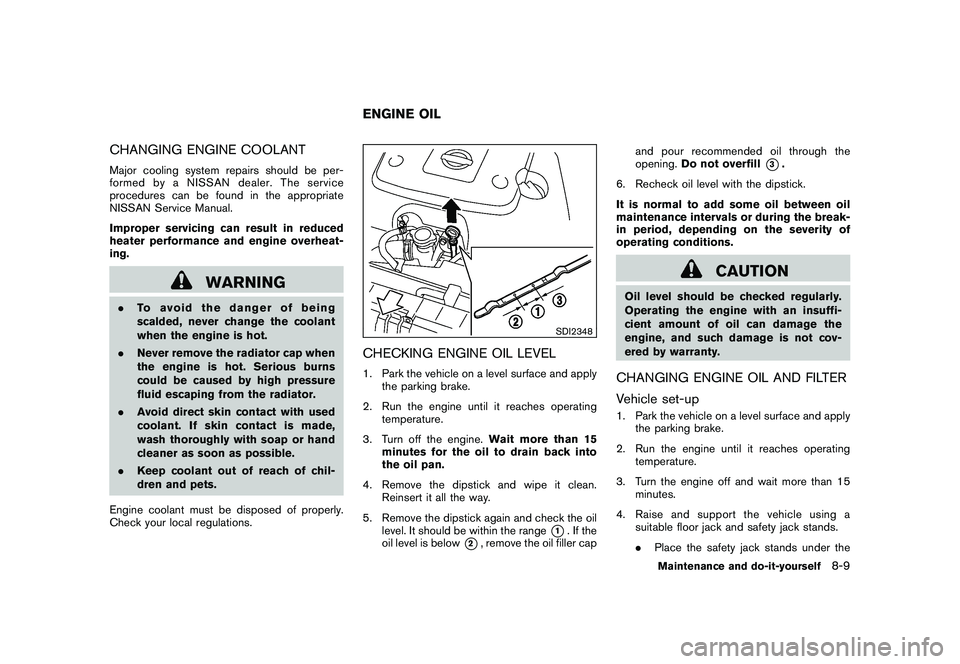
Black plate (349,1)
Model "Z34-D" EDITED: 2009/ 9/ 10
CHANGING ENGINE COOLANTMajor cooling system repairs should be per-
formed by a NISSAN dealer. The service
procedures can be found in the appropriate
NISSAN Service Manual.
Improper servicing can result in reduced
heater performance and engine overheat-
ing.
WARNING
.To avoid the danger of being
scalded, never change the coolant
when the engine is hot.
. Never remove the radiator cap when
the engine is hot. Serious burns
could be caused by high pressure
fluid escaping from the radiator.
. Avoid direct skin contact with used
coolant. If skin contact is made,
wash thoroughly with soap or hand
cleaner as soon as possible.
. Keep coolant out of reach of chil-
dren and pets.
Engine coolant must be disposed of properly.
Check your local regulations.
SDI2348
CHECKING ENGINE OIL LEVEL1. Park the vehicle on a level surface and apply the parking brake.
2. Run the engine until it reaches operating temperature.
3. Turn off the engine. Wait more than 15
minutes for the oil to drain back into
the oil pan.
4. Remove the dipstick and wipe it clean. Reinsert it all the way.
5. Remove the dipstick again and check the oil level. It should be within the range
*1. If the
oil level is below
*2, remove the oil filler cap and pour recommended oil through the
opening.
Do not overfill
*3.
6. Recheck oil level with the dipstick.
It is normal to add some oil between oil
maintenance intervals or during the break-
in period, depending on the severity of
operating conditions.
CAUTION
Oil level should be checked regularly.
Operating the engine with an insuffi-
cient amount of oil can damage the
engine, and such damage is not cov-
ered by warranty.CHANGING ENGINE OIL AND FILTER
Vehicle set-up1. Park the vehicle on a level surface and apply the parking brake.
2. Run the engine until it reaches operating temperature.
3. Turn the engine off and wait more than 15 minutes.
4. Raise and support the vehicle using a suitable floor jack and safety jack stands.
.Place the safety jack stands under the
ENGINE OIL
Maintenance and do-it-yourself
8-9
Page 348 of 409
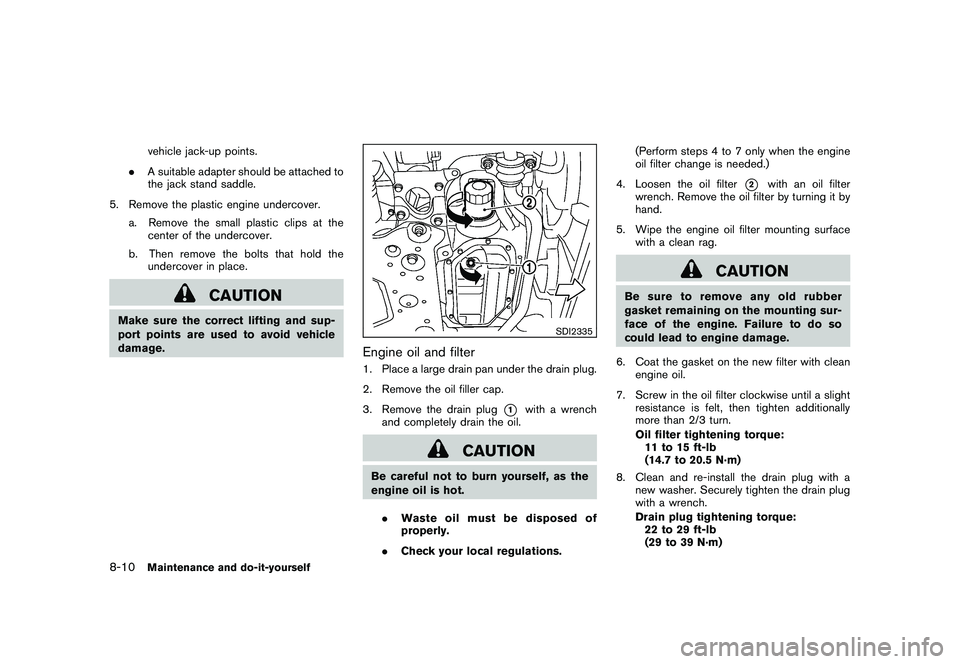
Black plate (350,1)
Model "Z34-D" EDITED: 2009/ 9/ 10
vehicle jack-up points.
. A suitable adapter should be attached to
the jack stand saddle.
5. Remove the plastic engine undercover. a. Remove the small plastic clips at thecenter of the undercover.
b. Then remove the bolts that hold the undercover in place.
CAUTION
Make sure the correct lifting and sup-
port points are used to avoid vehicle
damage.
SDI2335
Engine oil and filter1. Place a large drain pan under the drain plug.
2. Remove the oil filler cap.
3. Remove the drain plug
*1
with a wrench
and completely drain the oil.
CAUTION
Be careful not to burn yourself, as the
engine oil is hot.
. Waste oil must be disposed of
properly.
. Check your local regulations. (Perform steps 4 to 7 only when the engine
oil filter change is needed.)
4. Loosen the oil filter
*2
with an oil filter
wrench. Remove the oil filter by turning it by
hand.
5. Wipe the engine oil filter mounting surface with a clean rag.
CAUTION
Be sure to remove any old rubber
gasket remaining on the mounting sur-
face of the engine. Failure to do so
could lead to engine damage.
6. Coat the gasket on the new filter with clean engine oil.
7. Screw in the oil filter clockwise until a slight resistance is felt, then tighten additionally
more than 2/3 turn.
Oil filter tightening torque:11 to 15 ft-lb
(14.7 to 20.5 N·m)
8. Clean and re-install the drain plug with a new washer. Securely tighten the drain plug
with a wrench.
Drain plug tightening torque:22 to 29 ft-lb
(29 to 39 N·m)
8-10
Maintenance and do-it-yourself
Page 378 of 409
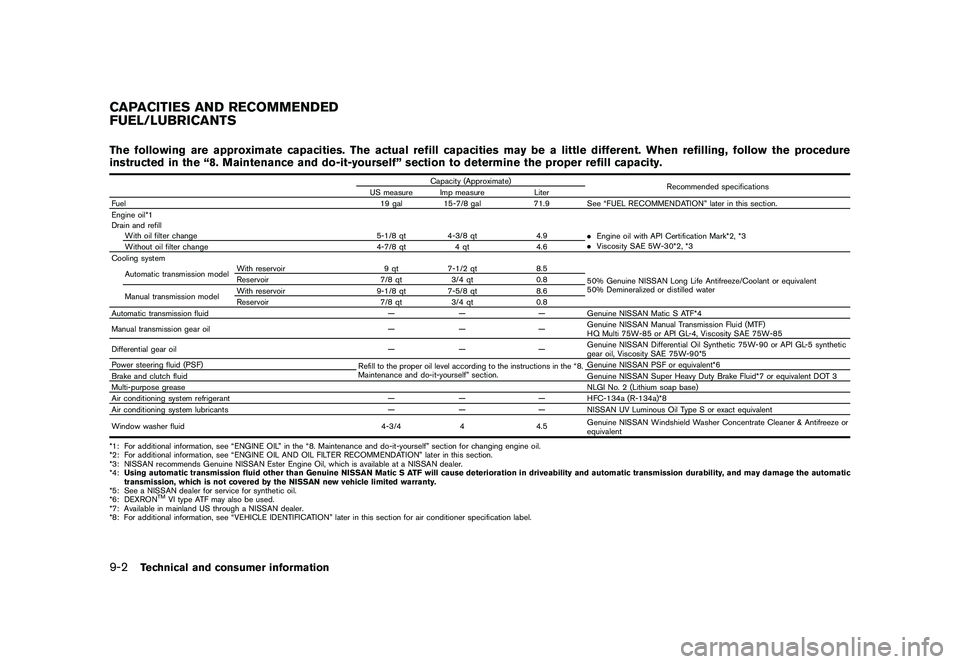
Black plate (380,1)
Model "Z34-D" EDITED: 2009/ 9/ 10
The following are approximate capacities. The actual refill capacities may be a little different. When refilling, follow the procedure
instructed in the “8. Maintenance and do-it-yourself” section to determine the proper refill capacity.
Capacity (Approximate)Recommended specifications
US measure Imp measure Liter
Fuel 19 gal 15-7/8 gal 71.9 See “FUEL RECOMMENDATION” later in this section.
Engine oil*1
Drain and refill With oil filter change 5-1/8 qt 4-3/8 qt 4.9 .Engine oil with API Certification Mark*2, *3
. Viscosity SAE 5W-30*2, *3
Without oil filter change 4-7/8 qt 4 qt 4.6
Cooling system
Automatic transmission model With reservoir 9 qt 7-1/2 qt 8.5
50% Genuine NISSAN Long Life Antifreeze/Coolant or equivalent
50% Demineralized or distilled water
Reservoir 7/8 qt 3/4 qt 0.8
Manual transmission model With reservoir 9-1/8 qt 7-5/8 qt 8.6
Reservoir 7/8 qt 3/4 qt 0.8
Automatic transmission fluid —— —Genuine NISSAN Matic S ATF*4
Manual transmission gear oil —— —Genuine NISSAN Manual Transmission Fluid (MTF)
HQ Multi 75W-85 or API GL-4, Viscosity SAE 75W-85
Differential gear oil —— —Genuine NISSAN Differential Oil Synthetic 75W-90 or API GL-5 synthetic
gear oil, Viscosity SAE 75W-90*5
Power steering fluid (PSF) Refill to the proper oil level according to the instructions in the “8.
Maintenance and do-it-yourself” section.Genuine NISSAN PSF or equivalent*6
Brake and clutch fluid Genuine NISSAN Super Heavy Duty Brake Fluid*7 or equivalent DOT 3
Multi-purpose grease NLGI No. 2 (Lithium soap base)
Air conditioning system refrigerant —— —HFC-134a (R-134a)*8
Air conditioning system lubricants —— —NISSAN UV Luminous Oil Type S or exact equivalent
Window washer fluid 4-3/444.5Genuine NISSAN Windshield Washer Concentrate Cleaner & Antifreeze or
equivalent
*1: For additional information, see “ENGINE OIL” in the “8. Maintenance and do-it-yourself” section for changing engine oil.
*2: For additional information, see “ENGINE OIL AND OIL FILTER RECOMMENDATION” later in this section.
*3: NISSAN recommends Genuine NISSAN Ester Engine Oil, which is available at a NISSAN dealer.
*4: Using automatic transmission fluid other than Genuine NISSAN Matic S ATF will cause deterioration in driveability and automatic transmission durability, and may damage the automatic
transmission, which is not covered by the NISSAN new vehicle limited warranty.
*5: See a NISSAN dealer for service for synthetic oil.
*6: DEXRON
TMVI type ATF may also be used.
*7: Available in mainland US through a NISSAN dealer.
*8: For additional information, see “VEHICLE IDENTIFICATION” later in this section for air conditioner specification label.
CAPACITIES AND RECOMMENDED
FUEL/LUBRICANTS9-2
Technical and consumer information
Page 381 of 409
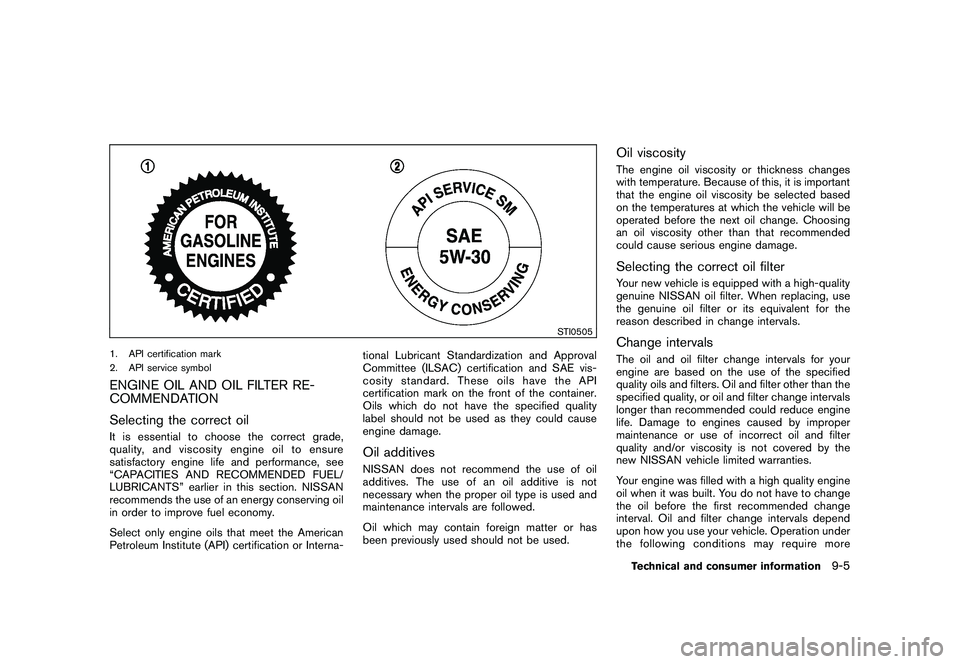
Black plate (383,1)
Model "Z34-D" EDITED: 2009/ 9/ 10
STI0505
1. API certification mark
2. API service symbolENGINE OIL AND OIL FILTER RE-
COMMENDATION
Selecting the correct oilIt is essential to choose the correct grade,
quality, and viscosity engine oil to ensure
satisfactory engine life and performance, see
“CAPACITIES AND RECOMMENDED FUEL/
LUBRICANTS” earlier in this section. NISSAN
recommends the use of an energy conserving oil
in order to improve fuel economy.
Select only engine oils that meet the American
Petroleum Institute (API) certification or Interna-tional Lubricant Standardization and Approval
Committee (ILSAC) certification and SAE vis-
cosity standard. These oils have the API
certification mark on the front of the container.
Oils which do not have the specified quality
label should not be used as they could cause
engine damage.
Oil additivesNISSAN does not recommend the use of oil
additives. The use of an oil additive is not
necessary when the proper oil type is used and
maintenance intervals are followed.
Oil which may contain foreign matter or has
been previously used should not be used.
Oil viscosityThe engine oil viscosity or thickness changes
with temperature. Because of this, it is important
that the engine oil viscosity be selected based
on the temperatures at which the vehicle will be
operated before the next oil change. Choosing
an oil viscosity other than that recommended
could cause serious engine damage.Selecting the correct oil filterYour new vehicle is equipped with a high-quality
genuine NISSAN oil filter. When replacing, use
the genuine oil filter or its equivalent for the
reason described in change intervals.Change intervalsThe oil and oil filter change intervals for your
engine are based on the use of the specified
quality oils and filters. Oil and filter other than the
specified quality, or oil and filter change intervals
longer than recommended could reduce engine
life. Damage to engines caused by improper
maintenance or use of incorrect oil and filter
quality and/or viscosity is not covered by the
new NISSAN vehicle limited warranties.
Your engine was filled with a high quality engine
oil when it was built. You do not have to change
the oil before the first recommended change
interval. Oil and filter change intervals depend
upon how you use your vehicle. Operation under
the following conditions may require more
Technical and consumer information
9-5
Page 382 of 409
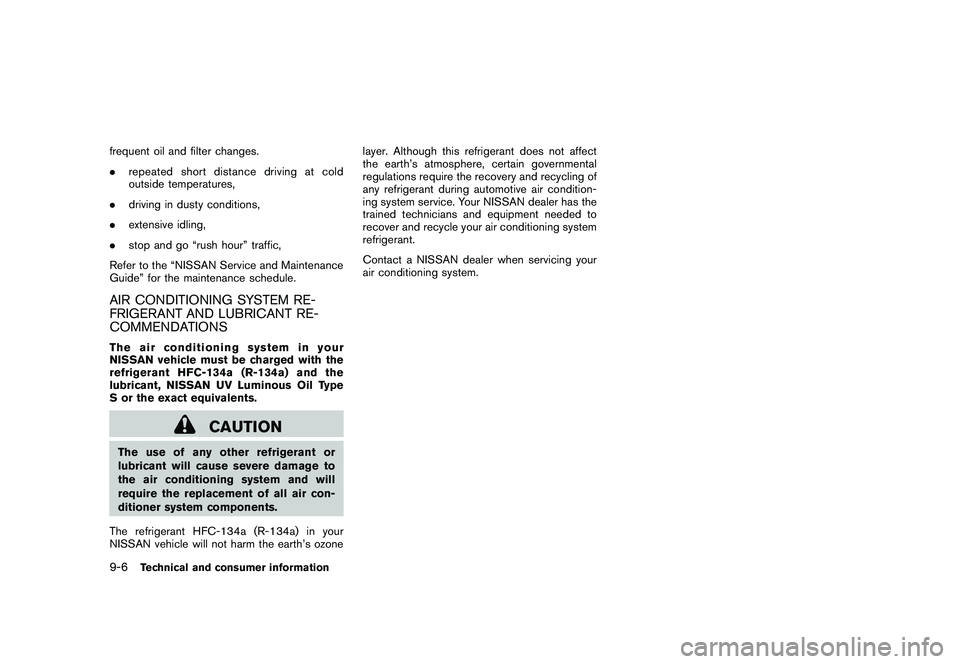
Black plate (384,1)
Model "Z34-D" EDITED: 2009/ 9/ 10
frequent oil and filter changes.
.repeated short distance driving at cold
outside temperatures,
. driving in dusty conditions,
. extensive idling,
. stop and go “rush hour” traffic,
Refer to the “NISSAN Service and Maintenance
Guide” for the maintenance schedule.AIR CONDITIONING SYSTEM RE-
FRIGERANT AND LUBRICANT RE-
COMMENDATIONSThe air conditioning system in your
NISSAN vehicle must be charged with the
refrigerant HFC-134a (R-134a) and the
lubricant, NISSAN UV Luminous Oil Type
S or the exact equivalents.
CAUTION
The use of any other refrigerant or
lubricant will cause severe damage to
the air conditioning system and will
require the replacement of all air con-
ditioner system components.
The refrigerant HFC-134a (R-134a) in your
NISSAN vehicle will not harm the earth’s ozone layer. Although this refrigerant does not affect
the earth’s atmosphere, certain governmental
regulations require the recovery and recycling of
any refrigerant during automotive air condition-
ing system service. Your NISSAN dealer has the
trained technicians and equipment needed to
recover and recycle your air conditioning system
refrigerant.
Contact a NISSAN dealer when servicing your
air conditioning system.9-6
Technical and consumer information
Page 402 of 409
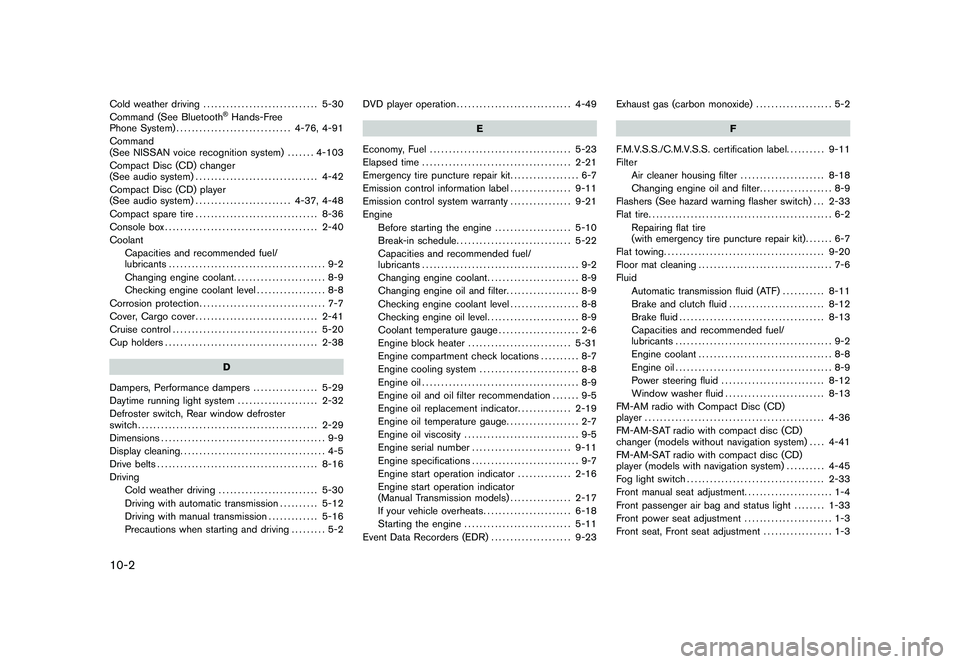
Black plate (2,1)
10-2Cold weather driving.............................. 5-30
Command (See Bluetooth
®Hands-Free
Phone System) .............................. 4-76, 4-91
Command
(See NISSAN voice recognition system) ....... 4-103
Compact Disc (CD) changer
(See audio system) ................................ 4-42
Compact Disc (CD) player
(See audio system) ......................... 4-37, 4-48
Compact spare tire ................................ 8-36
Console box ........................................ 2-40
Coolant Capacities and recommended fuel/
lubricants ......................................... 9-2
Changing engine coolant ........................ 8-9
Checking engine coolant level .................. 8-8
Corrosion protection ................................. 7-7
Cover, Cargo cover ................................ 2-41
Cruise control ...................................... 5-20
Cup holders ........................................ 2-38
D
Dampers, Performance dampers ................. 5-29
Daytime running light system ..................... 2-32
Defroster switch, Rear window defroster
switch ............................................... 2-29
Dimensions ........................................... 9-9
Display cleaning ...................................... 4-5
Drive belts .......................................... 8-16
Driving Cold weather driving .......................... 5-30
Driving with automatic transmission .......... 5-12
Driving with manual transmission ............. 5-16
Precautions when starting and driving ......... 5-2DVD player operation
.............................. 4-49
E
Economy, Fuel ..................................... 5-23
Elapsed time ....................................... 2-21
Emergency tire puncture repair kit .................. 6-7
Emission control information label ................ 9-11
Emission control system warranty ................ 9-21
Engine Before starting the engine .................... 5-10
Break-in schedule .............................. 5-22
Capacities and recommended fuel/
lubricants ......................................... 9-2
Changing engine coolant ........................ 8-9
Changing engine oil and filter ................... 8-9
Checking engine coolant level .................. 8-8
Checking engine oil level ........................ 8-9
Coolant temperature gauge ..................... 2-6
Engine block heater ........................... 5-31
Engine compartment check locations .......... 8-7
Engine cooling system .......................... 8-8
Engine oil ......................................... 8-9
Engine oil and oil filter recommendation ....... 9-5
Engine oil replacement indicator .............. 2-19
Engine oil temperature gauge ................... 2-7
Engine oil viscosity .............................. 9-5
Engine serial number .......................... 9-11
Engine specifications ............................ 9-7
Engine start operation indicator .............. 2-16
Engine start operation indicator
(Manual Transmission models) ................ 2-17
If your vehicle overheats ....................... 6-18
Starting the engine ............................ 5-11
Event Data Recorders (EDR) ..................... 9-23Exhaust gas (carbon monoxide)
.................... 5-2
F
F.M.V.S.S./C.M.V.S.S. certification label. ......... 9-11
Filter Air cleaner housing filter ...................... 8-18
Changing engine oil and filter ................... 8-9
Flashers (See hazard warning flasher switch) . . . 2-33
Flat tire ................................................ 6-2
Repairing flat tire
(with emergency tire puncture repair kit) ....... 6-7
Flat towing .......................................... 9-20
Floor mat cleaning ................................... 7-6
Fluid Automatic transmission fluid (ATF) ........... 8-11
Brake and clutch fluid ......................... 8-12
Brake fluid ...................................... 8-13
Capacities and recommended fuel/
lubricants ......................................... 9-2
Engine coolant ................................... 8-8
Engine oil ......................................... 8-9
Power steering fluid ........................... 8-12
Window washer fluid .......................... 8-13
FM-AM radio with Compact Disc (CD)
player ............................................... 4-36
FM-AM-SAT radio with compact disc (CD)
changer (models without navigation system) .... 4-41
FM-AM-SAT radio with compact disc (CD)
player (models with navigation system) .......... 4-45
Fog light switch .................................... 2-33
Front manual seat adjustment. ...................... 1-4
Front passenger air bag and status light ........ 1-33
Front power seat adjustment ....................... 1-3
Front seat, Front seat adjustment .................. 1-3
Model "Z34-D" EDITED: 2009/ 9/ 10